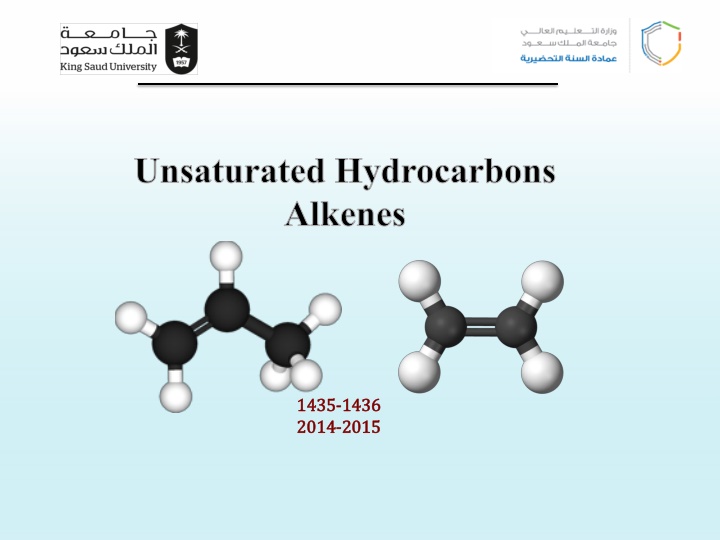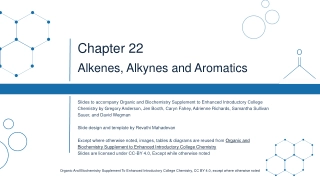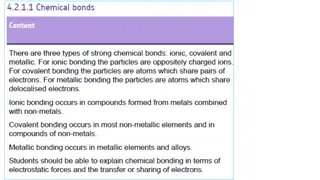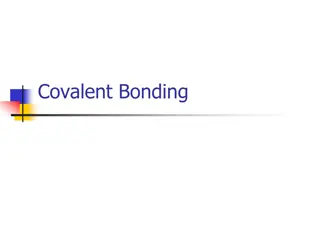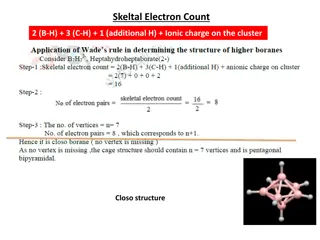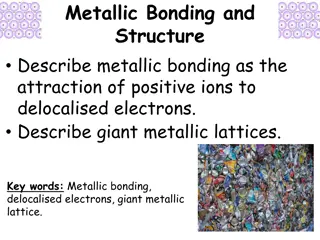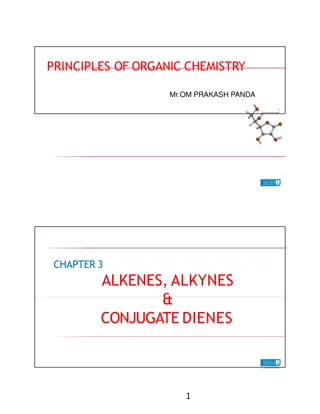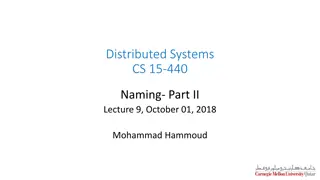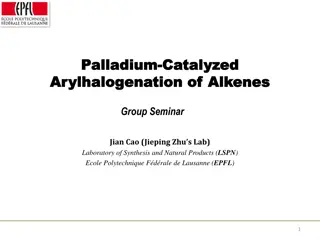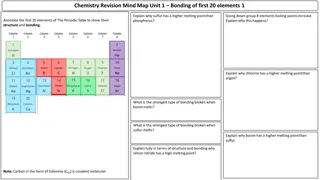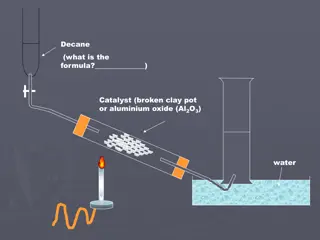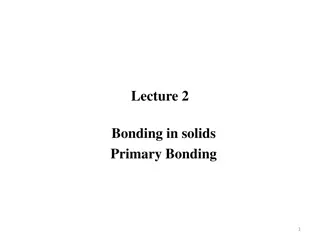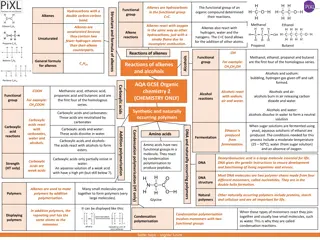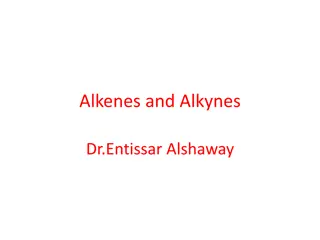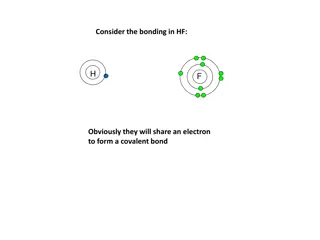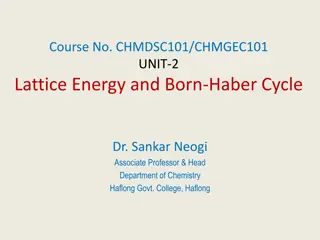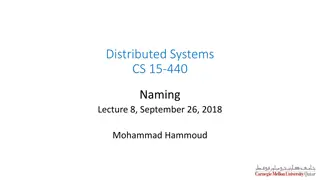Alkenes: Structure, Bonding, and Naming
Alkenes are unsaturated hydrocarbons containing a C=C double bond. This chapter covers topics such as alkene structure, hybridization, naming, isomerization, physical properties, preparation methods, stability rules, and addition reactions. Learn about the sp2 hybridization of orbitals in alkenes, orbital overlap in ethene, and nomenclature of alkenes and cycloalkenes.
Download Presentation

Please find below an Image/Link to download the presentation.
The content on the website is provided AS IS for your information and personal use only. It may not be sold, licensed, or shared on other websites without obtaining consent from the author.If you encounter any issues during the download, it is possible that the publisher has removed the file from their server.
You are allowed to download the files provided on this website for personal or commercial use, subject to the condition that they are used lawfully. All files are the property of their respective owners.
The content on the website is provided AS IS for your information and personal use only. It may not be sold, licensed, or shared on other websites without obtaining consent from the author.
E N D
Presentation Transcript
Unsaturated Hydrocarbons Alkenes 1435 1435- -1436 2014 2014- -2015 1436 2015
Alkenes Learning Objectives Chapter two discusses the following topics and the student by the end of this chapter will: Know the structure, hybridization and bonding of alkenes Know the common and IUPAC naming of alkenes Know the geometry of the double bond i.e. cis/trans isomerization Know the physical properties of alkenes Know the different methods used for preparation of alkenes (elimination reactions ; dehydrogenation, dehydration and alkenes stability (Zaitsev s rule) play an important role in understanding these reactions Know the addition reactions of alkenes and the effect of Markovnikov s rule in determining the regioselectivity of this reaction.
Alkenes Structure Of Alkenes They are unsaturated hydrocarbons made up of C and H atoms and contain one or more C=C double bond somewhere in their structures. Their general formula is CnH2n - for non-cyclic alkenes Their general formula is CnH2n-2 - for cyclic alkenes 3
Alkenes sp2 Hybridization Of Orbitals In Alkenes The electronic configuration of a carbon atom is 1s22s22p2 Thus 2p3 2s2 2s1 3 x sp2 2p 2p2 promotion hybridization Trigonal planar
Alkenes Orbital Overlap In Ethene In ethylene (ethene), each carbon atom use an sp2 orbital to form a single C-C bond. Because of the two sp2 orbitals overlap by end- to- end the resulting bond is called bond. The pi ( ) bond between the two carbon atoms is formed by side- by-side overlap of the two unhybridized p- orbitals (2p 2p ) for maximum overlap and hencethe strongest bond, the 2p orbitals are in line and perpendicular to the molecular plane. This gives rise to the planar arrangement around C=C bonds. Also s orbitals of hydrogen atoms overlap with the sp2 orbitals in carbon atoms to form two C-H bonds with each carbon atom. The resulting shape of ethene molecule is planar with bond angles of 120 and C=C bond length is 1.34 http://upload.wikimedia.org/wikipedia/commons/thumb/8/8d/Ethene-2D-flat.png/220px-Ethene-2D-flat.png 5
Alkenes Orbital Overlap In Ethene two sp2 orbitals overlap to form a sigma bond between the two carbon atoms sp2 hybridized carbon atoms s orbitals in hydrogen atoms overlap with the sp2 orbitals in carbon atoms to form C-H bonds two 2p orbitals overlap to form a pi bond between the two carbon atoms the resulting shape is planar with bond angles of 120 and C=C (1.34 ) 6
Alkenes Nomencalture Of Alkenes And Cycloalkenes 1. Alkene common names: CH3 CH2 H2C CH2 CH3-CH CH2 H3C C Common: Ethylene Propylene Isobutene Substituent groups containing double bonds are: H2C=CH Vinyl group H2C=CH CH2 Allyl group Br Cl Common: Allyl bromide Vinyl chlorride 7
Alkenes 2. IUPAC Nomenclature Of Alkenes Find the longest continuous Carbon chain containing the double bond this determines the root name then add the suffix -ene. Number the C- chain from the end that is nearer to the double bond. Indicate the location of the double bond by using the number of the first atom of the double bond just before the suffix ene or as a prefix. 1 2 3 4 5 6 1 2 3 4 H2C CH CH2CH3 CH3CH Hex-2-ene or 2-Hexene (not 4-Hexene) CHCH2CH2CH3 But-1-ene or 1-Butene (not 3-Butene) Indicate the positions of the substituents using numbers of carbon atoms to which they are bonded and write their names in alphabetical order (N.B. discard the suffixes tert-, di, tri,---when alphabetize the substituents) and if more than one substituent of the same type are present use the prefixes di- or tri or tetra or penta,--- to indicate their numbers. 8
Alkenes 8 Cl CH3 7 1 5 3 H3C C 2 CH 3 CH3 4 4 6 6 1 2 4 2 2-Methyl-but-2-ene or 2-Methyl-2-butene (not 3-Methyl-2-butene) 3 5 1 CH3 6-Methyl-2-octene 3-Chloro-2-hexene (not 2-Chloro-1-methyl-1-pentene) Br 1 3 CH3-CH2-CH2-CH=CH-C-CH3 5 6 7 4 (CH3CHCHCH2OCH3) = OCH3 2 1 3 4 2 Br CH3 1-Methoxy-but-2-ene (not 4-Methoxy-but-2-ene) 2,2-Dibromo-3-heptene (not 6,6-Dibromo-4-heptene) 1 3 5 2 1 2 4 2 3 9 3 5 7 1 CN 6 4 8 5-Methylcyclopenta-1,3-diene An ''a'' is added due to inclusion of di put two consonants consecutive 4-Cyano-2-ethyl-1-pentene (not 2-Ethyl-4-cyano-1-pentene) 2,3,7-Trimethyl-non-3-ene (not 2-Isopropyl-6-methyl--2-octene)
Alkenes In cycloalkenes the double bond carbons are assigned ring locations #1 and #2. Which of the two is #1 may be determined by the nearest substituent rule. 1 CH3 2 6 1 3 5 H3C CH3 4 3,5-Dimethyl-cyclohexene (not 4,6-Dimethylcyclohexen) (not 1,5-Dimethyl-2-cyclohexen) 1-Methyl cyclopentene (not 2-Methylcyclopeneten) If the substituents on both sides of the = bond are at the same distance, the numbering should start from the side that gives the substituents with lower alphabet the lower number. 1 2 3 4 7 5 6 3-tert-Butyl-7-isopropyl-cycloheptene (not 3-Isopropyl-7-tert-butylcycloheptene) 10
Alkenes When the longer chain cannot include the C=C, a substituent name is used. 1 2 1 3 CH CH2 CH CH2 6 5 4 Vinyl-cyclohexane 3-Vinyl-cyclohexene
Alkenes Geometrical Isomerism In Alkenes A B C G. I. found in some, but not all, alkenes It occurs in alkenes having two different groups / atoms attached to each carbon atom of the = bond D A=C or B=D No Cis or transe (G. I. X) A C B D, A =B or C=D Cis / A =D or C= B transe G. I. G. I. x 12 G. I. X G. I. G. I.
Alkenes Geometrical Isomerism In Alkenes It occurs due to the Restricted Rotation of C=C bonds so the groups on either end of the bond are fixed in one position in space; to flip between the two groups a bond must be broken. X Geometrical isomers can not convert to each at room temperature. 13
Alkenes Types Of Geometric Isomerism A) Cis / trans isomerism in alkenes Exhibited by alkenes having two H s and two other similar groups or atoms attached to each carbon atom of the = bond (or generally the alkene have only two types of atom or groups i.e. ABC=CAB) Cis prefix used when hydrogen atoms on both carbon atoms are on the SAME side of C=C bond Trans prefix used when non-hydrogen groups / atoms are on the opposite sides of C=C bond 14 Cis-But-2-ene Trans-But-2-ene
Alkenes H Cl H H H Cl Cl Cl cis-1,2-Dichloro-ethene trans-1,2-Dichloro-ethene Cis Trans Groups / atoms are on the Same Side of the double bond Groups / atoms are on Opposite Sides across the double bond = Cis-Oct-4-ene Trans-Oct-4-ene H H H H H CH3 H3C H CH3 H H H CH3 cis-cis-2,4-hexadiene H trans-trans-2,4-hexadiene trans-4-ethyl-3-heptene 15
Alkenes B) Z/ E isomerism in alkenes If the groups attached to the C=C are different, we distinguish the two isomers by adding the prefix Z (from German word Zusammen) if the higher-priority groups are together in the same side or E (from German word Entgegen) if the higher- priority groups are opposite sides depending on the atomic number of the atoms attached to each end of the C=C. Atoms with higher atomic numbers receive higher priority I> Br > Cl > F > O > N > C > H 16
Alkenes 17
Alkenes Br I CH3 I CH3 Cl Br Cl Z-2-bromo-1-chloro-1-iodopropene E-2-bromo-1-chloro-1-iodopropene O I CH3 CH2 Cl H C CH3 H H O Z Z 18
Alkenes Exercise Q1-Which of the following compounds can exhibit cis / trans isomerism a) 2-Methylpropene b) 1-Butene c) 2-Methyl-2-pentene d) 2-Butene e) 3-Methyl-2-hexene Q2- Name the following compounds according to IUPAC system c) b) a) 19
Alkenes 3 5 4 2 2 4 Br 1 3 1 3-Bromo propene 2-Ethyl-4-methyl pentene CH3 CH3 6 1 5 6 5 4 2 4 1 3 3 2 Cl Cl CH3 CH3 4-Chloro-3,6-dimethylcyclohexene 3-Chloro-2,5-dimethylcyclohexene 1 H3C CH3 Br Br H Cl C C C C C 2 C 3 H H H Cl H CH2CH3 4 1,1-Dichloroethene 5 E-3-Methyl-2-pentene Cis-1,2-Dibromoethene Geometrical isomerism not geometrical isomerism 2 4 6 1 3 5 7 Trans-trans-2,4-heptadiene Trans-1,3,5-heptatriene 20 Cis-cis-2,5-heptadiene Home work
Alkenes Physical Properties of Alkenes Alkenes are nonpolar compounds thus: Insoluble in water Soluble in nonpolar solvents ( hexane, benzene, ) The boiling point of alkenes increase as the number of carbons increase. 21
Alkenes Preparation Of Aalkenes 1- Dehydration of alcohols ( removal of OH group and a proton from two adjacent carbon atoms ) using mineral acids such as H2SO4 or H3PO4 Conc.H2SO4 CH3CH2OH CH2 + H2 C H2 O 180 oC Ethanol Ethene OH H+/ heat + H2 O H cyclohexanol cyclohexene 22
Alkenes Zaitsev sRule If there are different protons can be eliminated with the hydroxyl group or with halogen atom, in this case more than one alkene can be formed, the major product will be the alkene with the most alkyl substituents attached to the double bonded carbon. H2C CH3 + H2O H3C H / Heat 1- Butene Minor CH3 OH H3C CH3+ H2O 2- Butene Major Zaitsev rule: an elimination occurs to give the most stable, more highly substituted alkene 23
Alkenes 2- Dehydrohalogenation of alkyl halides using a base or NaOH 24
Alkenes 3. Dehalogenation of vicinal dihalides Zn/AcOH Br Br For example: Dehalogenation of 1,2-Dibromobutane leads to the formation of 1- Butene. In the presence of catalyst ( AcOH acetic acid). 25
Alkenes Reactions Of Alkenes Oxidation Reactions KMnO4 Ozonolysis Reactions of Alkenes Addition(Electrophilic) reaction: - Hydrogenation - Halogenation - Hydrohalogenation - Halohydrin formation -Hydration 26
Alkenes An electrophile, an electron-poor species,(from the Greek words meaning electron loving). It is a species (any molecule, ion or atom) that accept a pair of electrons to form a new covalent bond. , H , Br , Cl , I , etc., AlCl3 , BF3 , FeCl3 , FeBr3 , etc. C A nucleophile, an electron-rich species, ,(from the Greek words meaning nucleus loving). It is a species (any molecule, ion or atom) that donate an electron pair to form a new covalent bond. , OH , Br , Cl , I , etc., H2N, HS, etc., H2O , C , etc. CH3OH , RNH2 , R2NH , R3N , 27
Alkenes Electrophilic Addition Reaction 1- Additions To The Carbon-Carbon Double Bond 1.1 Addition Of Hydrogen: Hydrogenation (Reduction) A A + A A Pt or Ni or Pd H2 A A A A H H An alkane An alkene Pt CH2 + H2 H2 C H3 C CH3 H3 C CH2+ H2 H3 C Pt CH3 CH3 CH3 Pt + H2 CH3 CH3 Cis-1,2-Dimethyl cyclohexane 28
Alkenes 1.2.Addition of Halogens( Halogenation) A A A A + X2 A A (X= Cl or Br) A A X X Cl CCl4 CH3+ H3 C Cl2 H3 C CH3 Cl Br CCl4 + Br2 Br CH3 Br CH3 + CCl4 Br2 Br CH3 CH3 29 Trans-1,2- Dibromo-1,2-Dimethyl cyclohexane
Alkenes 1.3. Addition of Hydrogen Halides Only one product is possible from the addition of these strong acids to symmetrical alkenes such as ethene, 2-butene and cyclohexene. A A A A A A + HX A A (x= Cl or Br or I) H X Cl CH3 + HCl H3C H H + HI I However, if the double bond carbon atoms are not structurally equivalent, i.e. unsymmetrical alkenes as in molecules of 1- propene, 1-butene, 2-methyl-2-butene and 1- methylcyclohexene, the reagent may add in two different ways to give two isomeric products. This is shown for 1-propene in the following equation. 30
Alkenes Br CH3CHCH3 2o Carbocation CH3CHCH3 maijor HBr Br CH3CH=CH2 Br CH3CH2CH2 1o Carbocation CH3CH2CH2Br minor Stability of carbocation H3C CH3 H3C CH2CH2 C CH CH3 CH3 CH3 2o 1o 3o 31
Alkenes However when the addition reactions to such unsymmetrical alkenes are carried out, it was found that 2-bromopropane is nearly the exclusive product. Thus it said the reaction proceeded according to Markovnikov s rule Markovnikov s rule stats that : In addition of unsymmetrical reagent to unsymmetrical alkenes the positive ionaddsto the carbon of the alkene that bears the greater number of hydrogen atoms and the negative ion adds to the other carbon of the alkene. CH3 CH3Cl + HCl CH3 CH3 H3C H3C 32
Alkenes 1.4. Addition of HOX halogen in aqueous solution ( -OH, X+): Halohydrin formation Only one product is possible from the addition of HOX acids (formed from mixture of H2O and X2) to symmetrical alkenes such as ethene and cyclohexene. Symmetrical akenes A A A A A A (x= Cl or Br ) + H2O / X2 A A OH X Cl + H2O / Cl2 CH3 H3C OH 33
Alkenes However, addition reactions to unsymmetrical alkenes will result in the formation of Markovonikov s product preferentially. Unsymmetrical akenes OH + H2O / Cl2 Cl CH2Br + H2O / Br2 OH 34
Alkenes 1.5. Addition of H2O: Hydration Only one product is possible from the addition of H2O in presence of acids as catalysts to symmetrical alkenes such as ethene and cyclohexene. Symmetrical akenes A A A A H A A + H2O A A H OH OH H CH3 + H2O H3C H However, addition reactions to unsymmetrical alkenes will result in the formation of Markovonikov s product preferentially. Unsymmetrical akenes H H OH 35 + H2O CH3 CH3
Alkenes 2-Oxidation Reaction: 2.1- Ozonolysis: Oxidation with ozone (Oxidative cleavage): This reaction involves rupture of the C=C to give aldehydes or ketones according to the structure of the original alkene. A A A A A A A Zn /H2O - H2O2 A + O3 O O + A A A O O A O ( A= H or R) i) O3 ii) Zn /H2O O + O H i) O3 ii) Zn /H2O O + O O i) O3 ii) Zn /H2O 36 O
Alkenes 2- Oxidation with KMnO4(Oxidative addition): OH KMnO4 / OH/ H2O OH Cis- diol 37
Alkenes Thank You for your kind attention ! Questions? Comments 38
